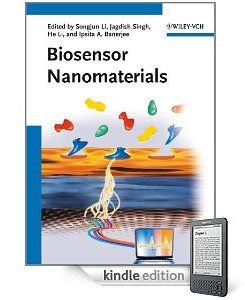Biosensor Nanomaterials, a new book that describes about materials for biosensor applications, has been added to Research and Markets' offerings.
Each chapter provides information on how particular nanomaterials, such as quantum dots, nanotubes, meso- and nanoporous materials and nanoparticles suitable for respective devices, can be prepared using appropriate methods, surface processing, or self-assembling technique.
 Biosensor Nanomaterials
Biosensor Nanomaterials
The detection methods included in this book are optical, electrochemical, and mechanical that helps in performing difficult tasks. Optical method explains how to identify fluorescence signals. Electrochemical method detects changes in pH value or resistivity, while the mechanical method enables quantifying macroscopic pressure inclinations or nanoscale level of direct mechanical deformations. The book provides references to researchers and other users by depicting what and why a nanomaterial is suitable for a particular application.
The important topics explained in this book include development and evaluation of nanoparticle-based biosensors, semiconductor quantum dots for electrochemical biosensors, advanced nanoparticles in medical biosensors, smart polymeric nanofibers resolving biorecognition issues, new micro- and nanotechnologies for electrochemical biosensor development, nanomaterials for optical imaging, current frontiers in electrochemical biosensors utilizing chitosan nanocomposites, functionalized graphene for biosensing applications, enzyme-based biosensors - synthesis and applications, energy harvesting for biosensors utilizing biofriendly materials, nanomaterials as promising DNA biosensors, nanocomposites and their biosensor applications, and carbon nanotubes - in vitro and in vivo sensing and imaging, lipid nanoparticle-mediated detection of proteins.